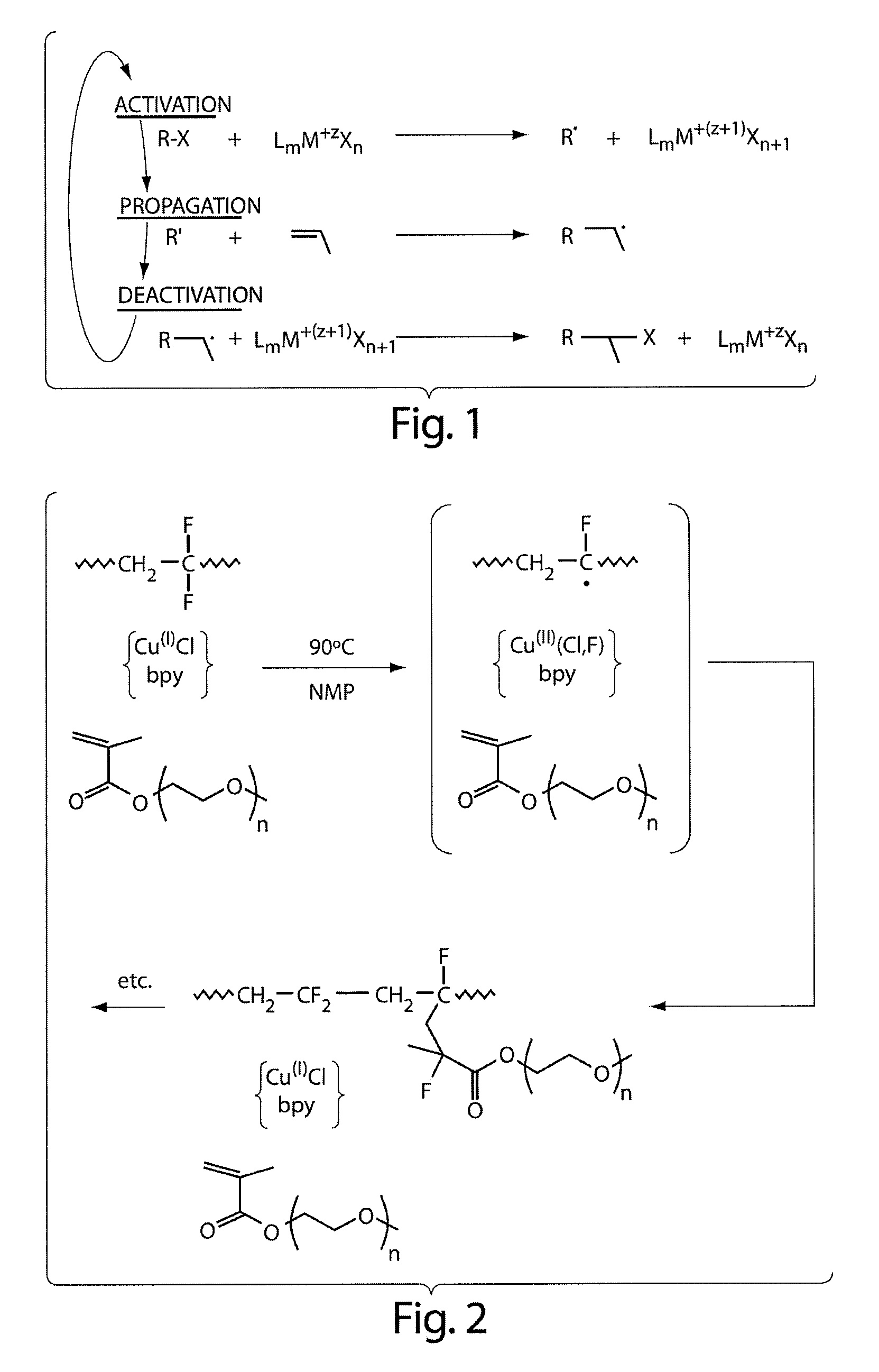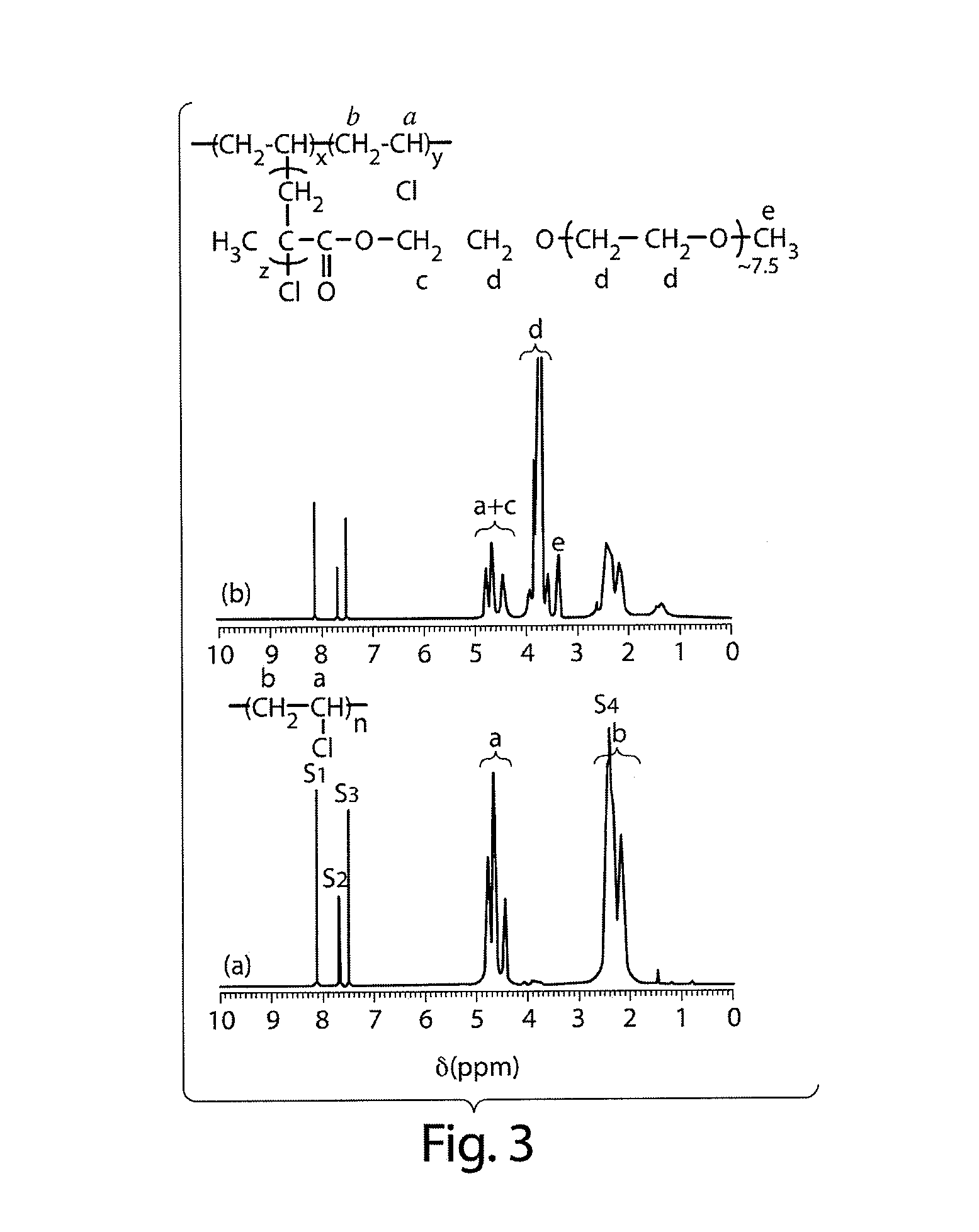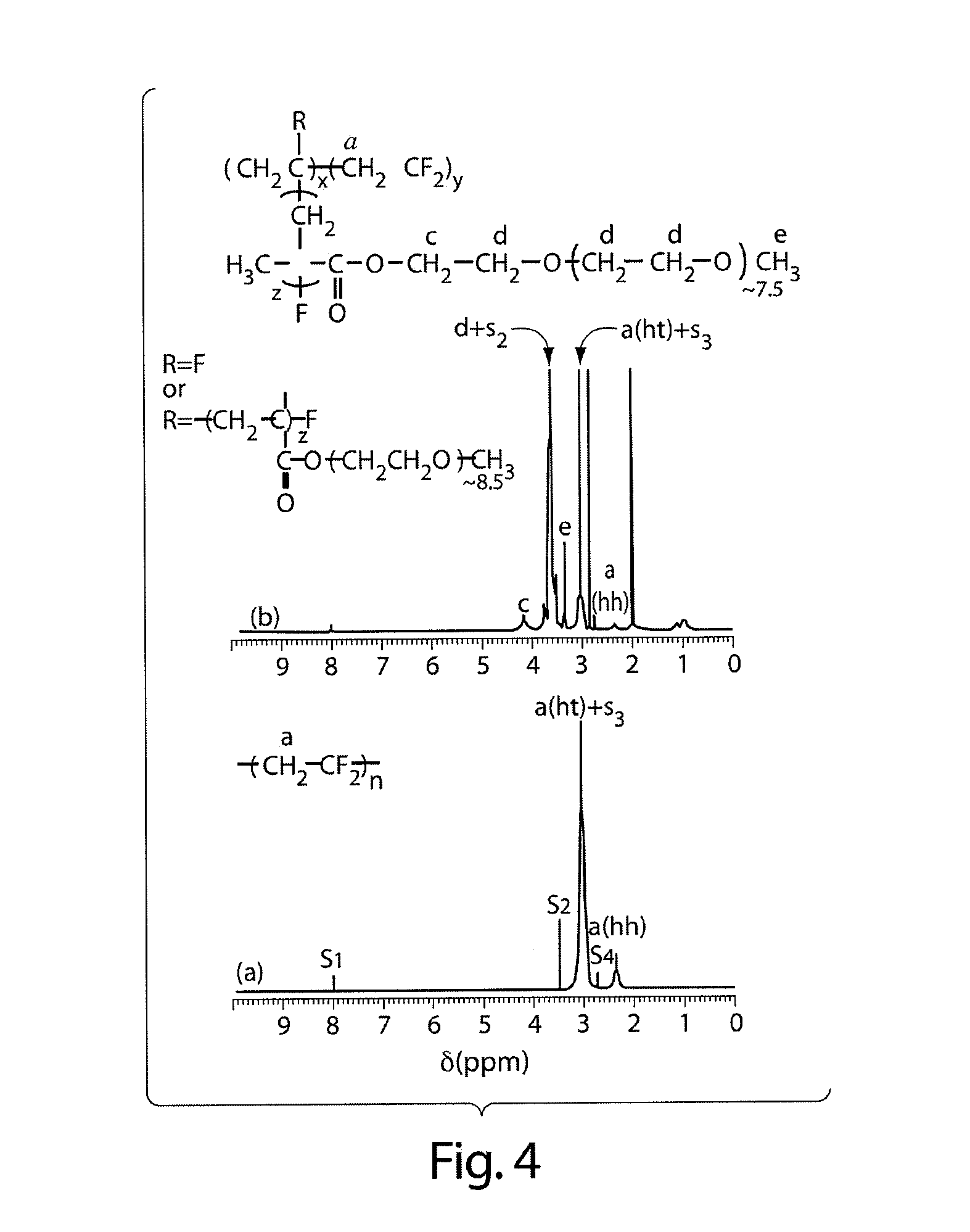Graft copolymers, methods for grafting hydrophilic chains onto hydrophobic polymers, and articles thereof
a technology of hydrophilic chains and copolymers, applied in the field of hydrophobic polymers, can solve the problems of increased manufacturing cost of articles, insufficient chemical or mechanical stability of coatings not covalently attached, and difficulty in controlling the surface coverage of graft-polymerized coatings
- Summary
- Abstract
- Description
- Claims
- Application Information
AI Technical Summary
Problems solved by technology
Method used
Image
Examples
example 1
Synthesis of Graft Copolymers by ATRP with Initiation Via Secondary Halogen Atoms
[0079]Materials. Poly(vinylidene fluoride) (PVDF) ( Mn ca. 107 000 g / mol, Mw ca. 250 000 g / mol), poly(vinyl chloride) (PVC) (inherent viscosity 0.51), chlorinated polyethylene (cPE) (40 wt % Cl), POEM ( Mn=475 g / mol), tert-butyl methacrylate (tBMA), copper(I) chloride (CuCl), 4,4′-dimethyl-2,2′-dipyridyl (bpy), 1,1,4,7,10,10-hexamethyltriethylenetetramine (HMTA), p-toluenesulfonic acid (TSA), 1-methyl-2-pyrrolidinone (NMP), and N,N-dimethylformamide (DMF) were purchased from Aldrich Chemical Co. (Milwaukee, Wis.). Deuterated solvents were purchased from VWR. All reagents were used as received.
[0080]PVC-g-POEM. Synthesis Protocol. In a typical reaction, PVC (5 g) was weighed into a conical flask containing a Teflon stir bar and dissolved in DMF (40 ml). POEM (20 ml), CuCl (0.06 g), and HMTA (0.42 g) were then added to the reaction mixture, after which the conical flask was sealed with a rubber septum. Ar...
example 2
Thin Film Coatings
[0103]Materials. Chlorinated polypropylene (cPP) (isotactic, 26 wt % Cl), polysulfone (PSf) ( Mn ca. 26 000 g / mol), zinc oxide (ZnO), and chloromethyl ether were purchased from Aldrich Chemical Co. (Milwaukee, Wis.). Chloroform and deuterated solvents were purchased from VWR. (Tridecafluoro-1,1,2,2-tetrahydrooctyl)-1-dimethylchlorosilane was obtained from Gelest, Inc. (Bristol, Pa.). Cell culture reagents were purchased from Gibco. All reagents were used as received.
[0104]Synthesis of Additional Graft Copolymers. cPP-g-POEM. Synthesis Protocol. cPP (5 g), POEM (50 ml), CuCl (0.04 g), and HMTA (0.23 g) were dissolved in NMP in a conical flask, as above. The reaction vessel was similarly purged with argon gas, after which the reaction was performed at 90° C. for 48 h. The polymer was recovered and purified by successive precipitations in methanol / petroleum ether mixtures.
[0105]Characterization. cPP and its graft copolymer were characterized by 1H NMR in deuterated be...
example 3
Membranes
[0122]Materials. PVDF534K ( Mw ca. 534 000 g / mol), PVDF250K ( Mn ca. 107 000 g / mol, Mw ca. 250 000 g / mol), and polysulfone (PSf) ( Mn ca. 26 000 g / mol) were purchased from Aldrich Chemical Co. (Milwaukee, Wis.) and used as received.
[0123]Membrane Preparation. Membranes were prepared from casting solutions containing polymer(s), glycerol, and N,N-dimethylacetamide (DMAc) according to the compositions listed in Table 4. After filtering and degassing, each solution was cast onto a first-surface optical mirror (Edmund Scientific Co., Barrington, N.J.) under a casting bar having an 8-mil gate size. The mirror was then immersed in a bath of dW at 90° C. The membrane was removed from the bath after complete separation from the mirror and immersed overnight in a second dW bath at 20° C. Finally, membranes were dried in air at 20° C. Membranes of type I, II, and III contained 0, 5, and 10 wt % PVDF-g-POEM, respectively. Membranes of type IV and V contained 0 and 10 wt % PVDF-g-PMAA,...
PUM
| Property | Measurement | Unit |
|---|---|---|
| diameter | aaaaa | aaaaa |
| diameter | aaaaa | aaaaa |
| mean diameter | aaaaa | aaaaa |
Abstract
Description
Claims
Application Information
 Login to View More
Login to View More - R&D
- Intellectual Property
- Life Sciences
- Materials
- Tech Scout
- Unparalleled Data Quality
- Higher Quality Content
- 60% Fewer Hallucinations
Browse by: Latest US Patents, China's latest patents, Technical Efficacy Thesaurus, Application Domain, Technology Topic, Popular Technical Reports.
© 2025 PatSnap. All rights reserved.Legal|Privacy policy|Modern Slavery Act Transparency Statement|Sitemap|About US| Contact US: help@patsnap.com



